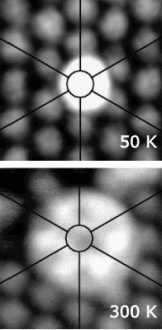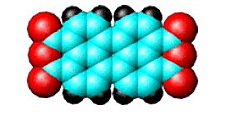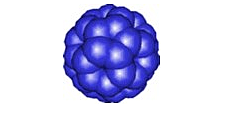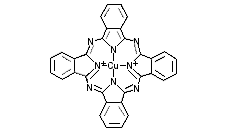Heterogeneous Organic Layers
By mixing molecules on surfaces ...
Maren Cottin, Christian Bobisch und Rolf Möller
The interaction between organic molecules is very complex: there are e.g. van der Waals and electrostatical forces. From the point of view of an theoretical scientist it would be very nice to switch on and off a certain contribution. For the real system this is of course not possible. But one can exchange the surrounding molecules. To reduce the dimensionality of the problem you can prepare mixed layers of molecules on a surface. The scanning tunneling microscope (STM) is a perfect tool to image the local structures formed by the two or more species of molecules. But STM is not limited to the topography. By doing scanning tunneling spectroscopy one can quantify the influence of the local enviroment on energetic states of individual molecules.
Mickey Mouse is doing surface science

One can study the interaction between different organic molecules easily if these form a mixed layer. This is the case for the system CuPc-PTCDA on Cu(111)1. One can prepare ultra-thin films with a total coverage below one monolayer on the clean single crystal surface by vacuum sublimation. But one has to pay attention to the sequence of evaporation: because PTCDA has distinct partial charges, CuPc cannot diffuse into a close packet island of PTCDA. Therefore, one has to dose CuPc firstly and then PTCDA.
By doing this we have been able to prepare four different mixed phases at the same time on the surface. They all differ by the ratio of the involved molecules and the packing density. The STM image on the right shows the "Mickey Mouse"-phase as one example. Here, one CuPc molecule and two PTCDA are included in one unit cell.
The structure of the CuPc within the image indicated that the local environment of the molecules influences their electronic structure: CuPc molecules have normally four equivalent "arms". In contrast to this, only the "arms" on different sites of the molecules have the same brightness. This asymmetry can be explained by the local enviroment where two PTCDA molecules are very close to these brighter "arms". It is hard to say from this STM image if the CuPc molecules is bent or it is only an effect related to a charge transfer between the CuPcs and the PTCDAs.
CuPc on C60: somewhat excentric

As for the system CuPc/C60 on Au(111)2, there is no mixed phase. Both molecules assemble in separated regions on the surface without intermixing. There are only individual CuPc molecules which stick on C60 islands. They appear in the STM images as stars with six maxima. This sixfold symmetry is in contrast to the four leaves of the molecules. In addition, the protrusion is one and a half times bigger than an individual CuPc molecule.
One can explain this by assuming that the CuPc molecules are not resting. Their movement is too fast to be imaged by STM. But the movement is not random: the CuPc molecule performs a random hopping between six equivalent adsorption sites. These are given by the underlying C60. You also have to assume that the adsorption site on the central C60 is not symmteric but excentric. We have proven this by cooling down the sample: at the low temperature the hindered rotation - a random hopping - is frozen. Only a smaller asymmetric protrusion is imaged. We carried out force field calculations to get a detailed path for the movement. In agreement with the experiments, we calculated an energy barrier for the hopping process of 44 meV.
Publications within this project
1"Ordered binary monolayer composed of two organic molecules: Copper-phthalocyanine and 3,4,9,10-perylene-tetra-carboxylic-dianhydride on Cu(111)",
C. Bobisch, Th. Wagner, A. Bannani, R. Möller,
J. Chem. Phys. 119(18), 9804 (2003)
2"Hindered rotation of a copper phthalocyanine molecule on C60: Experiments and molecular mechanics calculations",
M. Fendrich, Th. Wagner, M. Stöhr, and R. Möller,
Phys. Rev. B 73, 115433 (2006)



